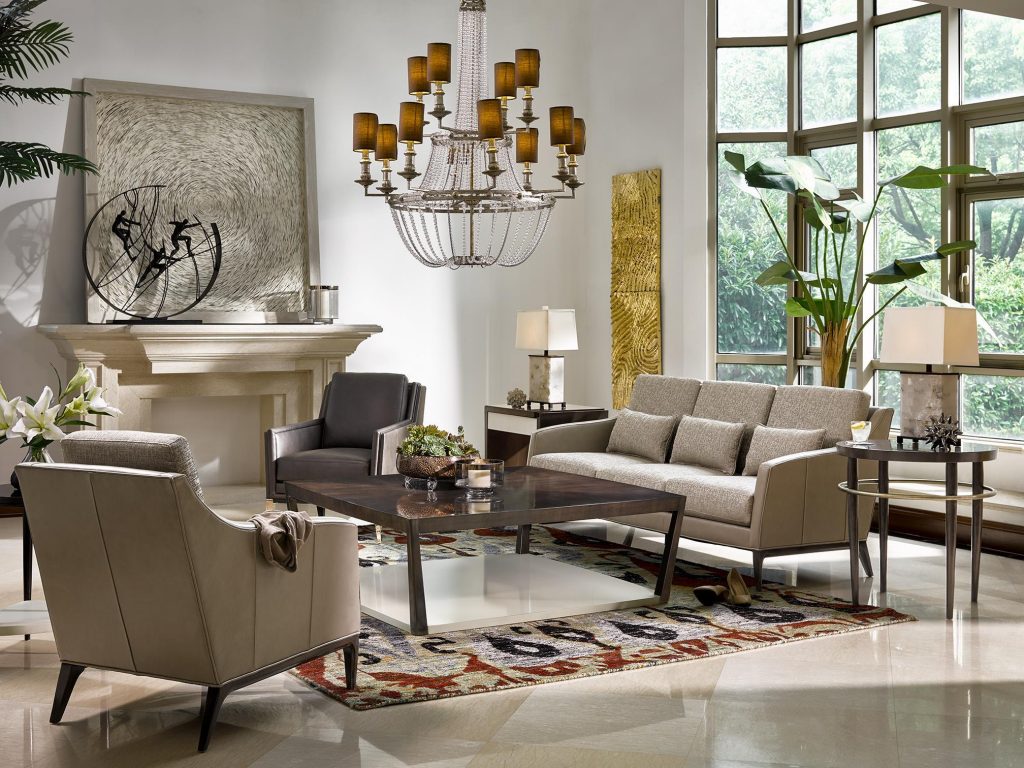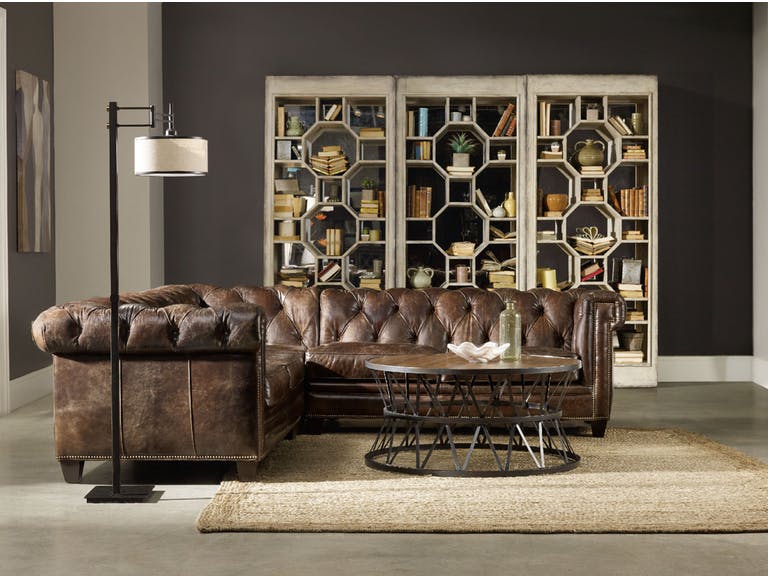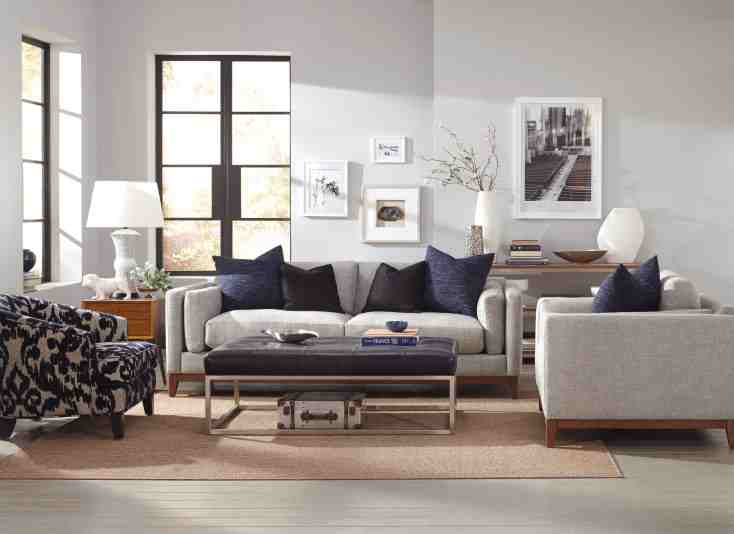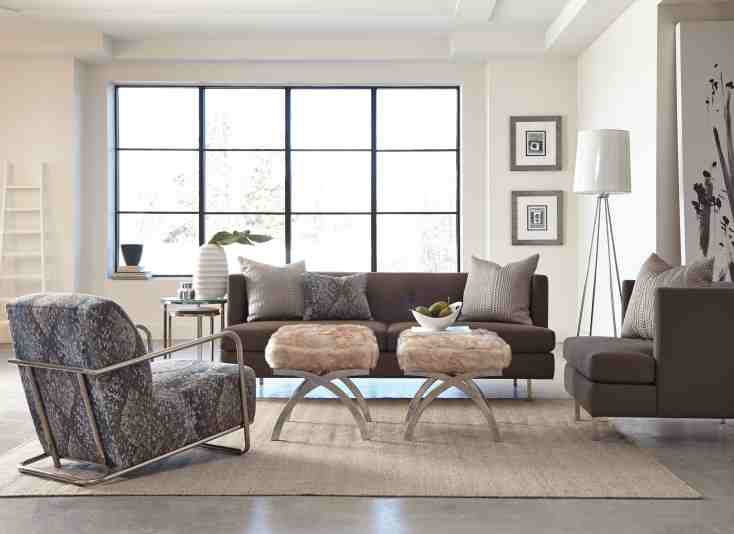Posts Tagged ‘living room design elements’
Tuesday, October 24th, 2017

Featured in this clean, predominantly white living room, is the Deco Reflets Cocktail Table from Fine Furniture Design.
Dictionary.com defines living room as a room in a home, used, especially by a family, for leisure activities, entertaining guests, etc. Another term for it is a parlor.
The history of the term living room dates back to the late nineteenth century. Decorative literature, back then, pointed out how this room should be the reflection of the person who designed it. This was a direct opposition to the prevailing style during the Victorian era when formal rooms were set up to receive guests.
The advent of the living room signaled the end for the more formal gathering spaces at the time.
And the Living Room Was Born
Since there is a name given to each room in a house (e.g. bathroom, bedroom, and the kitchen), it just follows that there must also be a name given to the liveliest portion of the home.
But did you know that before the living room was referred to in this term that it was actually called the Death Room?
Yes, believe it or not, the front room of houses during the Second World War, became the room where bodies were kept prior to their funeral. Influenza was widespread back then so many homes experienced deaths of loved ones.
When the conditions improved after the war, though, the Ladies Home Journal made a suggestion that the name be changed to living room. Prior to this, it was a room commonly referred to as the parlor, it being a French term parle, meaning, to speak.
This new term soon became more popular than parlor. Pretty soon, the living room became the center of parties, gatherings, and other social events. Even less formal setups for family members were done here.
The Living Room in the U.S.
In larger U.S. and Canadian homes, the living room can be reserved for quieter and more formal events. There are separate rooms for family activities and these are often referred to as the family room, den or the recreation room.
Breathing Life Into the Living Room
Remember that the living room is supposed to be a representation of who you are as the owner of that home so decorating this place means you should know what styles and colors attract you the most.
Begin by taking note of your current furniture and accessories. Get rid of outdated, damaged, and furniture pieces that are too small or too big for your home.
If you are blessed to have heirloom pieces, then find out how you can emphasize these treasures. If they don’t fit your living room, then find a new spot where they can be transferred to.
Next, pick a color palette. The colors that you choose will set the tone for your living room. A blue room will have a relaxing effect while orange or bright yellow living rooms will surely be energizing.
Be sure to build the color palette around an art piece that you need to emphasize in your living room. Choosing a color scheme means knowing which colors are warm and welcoming and which ones are calm and soothing to the eyes.
Know your style. Know the design principles for each style, for instance, traditional interior design tends to be more predictable, orderly, and classic. You won’t find any outdated furnishings in such a style. Accessories and furniture also usually come in pairs.
If these are not appealing to you, then, perhaps, you could go for contemporary or the eclectic styles. There are many designs to choose from, check our blog for them.
After determining your style, you will now have more fun designing your living room. This is the time to purchase new furniture such as the sofa, rug, as well as the entertainment center. Remember that these biggest pieces must reinforce your decorating style.
Tags: colors for the living room, decorating the living room, designing the living room, history of the living room, living room color palette, living room color scheme, living room color schemes, living room colors, living room concepts, living room design elements, living room designs, living room history, living room style, living room styles, McCreerys, McCreerys Home Furnishings
Posted in Interior Design 101, Interior Design Elements, Interior Design Themes, Living Room Design | Comments Off on The Living Room: Turning This Space Box to a Breathing, Living Space
Thursday, April 27th, 2017

Hooker Furniture Living Room Chester 3-Piece Stationary Sectional
Just like when you’re looking at fashion, the style that you choose for your home also says a lot about who you are. Of course, we don’t want to any conclusion just yet or quickly judge a book by its cover but it is not difficult to see who a person really is just looking at a room in his or her home.
Most houses describe their homeowners because they want the houses to say something about them. If you want your home to be traditional, comfortable and homey, then anything classic should be your choice.
You are leaning towards a contemporary style, on the other hand, if you love anything that’s linear and non-complex.
So, let’s define who you are by just one part of your home – the living room.
Your Living Room and You
Anyone who would walk into your living room should be able to know you a bit. The living room shouldn’t be merely a pretty room. There are various elements that comprise the experience within this room. These all have effects on how you feel or even how you relate to your surroundings.
Scientifically speaking, there are five ways that humans experience an environment. First, through your sense of touch, sight, hearing, taste and smell. Another way is through time. The third way is through memory, imagination or reasoning.
The fourth type is through emotions whether pleasant and unpleasant. Lastly, experiences become unique because of anticipation or expectations.
The living room should be filled with balanced colors, patterns, lighting and the best spatial arrangement that you can come up with. Candles and flowers can also make an appealing difference. Add texture to further please the senses. If you want your visitors to feel comfortable in your living room, then you should also feel that way when you are in that area.
It is also crucial to decide whether you will go for contemporary or traditional elements. If the environment you create is filled with classic pieces, then you may have a lot of stories to tell. Having a lot of wicker, rattan, bamboo or willow pieces may say that you love things that are natural. You could also be an advocate of environmentalism.
Another consideration for your living room is the amount of space that you can work on. Be sure to create a sense of fluidity from this area to other rooms of your home. Every space is created differently but when you’re considering space, think of movement patterns, even the distance of furniture pieces from each other.
If you want people to feel energized when they are in your living room then you should be ready to embrace warmer colors. These warm hues are great for people who use their living room as an activity or recreation center.
For those who want to use the living room as a more relaxing zone, then you need to pick cooler colors. Color psychology says a lot about the feelings or emotions that humans feel toward a particular color. The warmer ones such as red evokes increased activity while the cooler hues tend to relax the senses.
Having an organized living room could mean that you want things to be where they should be. This means that there are ample storage units to hold more stuff. The paintings, framed photographs and other works of art should be placed in a symmetrical or asymmetrical form.
All in all, it is crucial that you consider these elements for your living room’s total package. These will help you describe the room for a more enhanced experience. And with more people understanding who you really are, what a wonderful feeling everyone would feel as they step into your living room.
Tags: color psychology, living room design elements, McCreerys, McCreerys Home Furnishings
Posted in Interior Design 101, Interior Design Elements, Living Room Design | Comments Off on Your Living Room Says a Lot About You
Saturday, September 24th, 2016

7072-002CR Hamptons 3 Over 3 Sofa
Living rooms’ primary function is to gather family members in one space. Others believe that one’s identity can also be communicated through this room. There is a design criterion that needs to be met when setting up the living room. First, you have to recognize that this can be both a private and a public room. It’s a private room when you stay there with your loved ones or a public space when you’re hosting parties for friends.
Recognize that memories of your family time and moments with your friends in a living room could affect the connotation that they have for this space. After all, this space can be a place of solitude or a place for huge parties.
Know that hosting guests in a living room can include formal gathering or the more intimate scenarios.
Key Concepts
Every living room must have a sofa. Most families add a seating unit that is placed diagonally to this furniture piece. Some like placing a table in front of the sofa instead. Artwork can also be displayed on living room walls. Other objects can have the same purpose as artwork (e.g. framed photos, knickknacks, or gifts). Books are a common display on walls, too.
Not a lot of people spend moments of solitude such as writing, reading and contemplating inside the living room even when the physical elements in that space are used to foster privacy.
Tackling Living Room Design
There are two stages in designing the living room. First, take a step back and look at the bigger picture. Look at the room while it is still bare space. Next, find out how you can arrange the furnishings in the room.
Have a graphing paper and draw the room that you wish to achieve. There is no need to have a drafting degree for this kind of drawing. Have one square on the graph represent 6 inches; this means that a 10 by 8 feet space should have 20 by 16 squares.
Draw the doors, windows, furniture placements, and fireplaces, just about anything that you can move around. Now create some copies and use these as your sketchpad. You can go ahead and draw many different chair and sofa placements before anyone rearranges or sets up anything. Being able to view the room at an abstract sort of way can help you find new style options.
Figuring out the best layout for your living room means you have to prioritize flow, function as well as the focal point. The flow is the traffic pattern in a room. This is how people travel through the room and what paths are made available.
As for the room’s function, this can be defined by seeing the stuff that you will put in there. If the pieces are mainly TV, subwoofers, speakers, and such, then it’s a living room that’s mainly for entertainment. If it’s filled with shelves of books and a plush sofa plus a pair of floor lamps or a desk lamp paired with a wingbacked chair, then that living room is definitely a reading space.
A living room must also have a focal point. This if often the fireplace or a picturesque window. If you have all three – the picture window, fireplace and TV, then each should be placed on different walls. The traffic in the room must also be free-flowing.
Sometimes, it’s as easy as setting up the television. The focal point is what you and your family get to see as soon as they walk into the living room. The rest of the furniture and other design elements are arranged all around it.
Now it’s time to place the furniture at the right angles. This will offer a dynamic space. Leave no less than 36 inches of width for your living room traffic. Smaller groups of furniture should have 18 inches of space, at the very least, in front of them so that they can be accessed with ease.
Tags: designing the living room, history of the living room, living room concepts, living room design elements, living room furniture, living room style, McCreery's, McCreery's Home Furnishings, tips
Posted in Interior Design 101, Interior Design Elements, Living Room Design | No Comments »
Thursday, March 31st, 2016

This Kelsey Living Room Collection by Jonathan Louis depicts the exquisiteness of Nordic design.
Everyone knows that white is a reliable shade that can deliver astounding interior design results. It can make any space feel and look brighter, bigger and lighter. What’s great about white paint is that you don’t even have to waste time looking through piles of paint samples before you make your decision. Pulling off a white living room can be a tad more difficult to do, though.
What to Do with a White Living Room
Okay, so you’ve got a sort of blank canvas to work with. Let’s face it – those white walls would eventually look and feel boring if you don’t do something about them. A lot of white can look sterile or it is just too dull.
To get the best look with the color white, you need to consider bringing in some greenery. Green potted plants will stand out against the white walls and could even up the level of warmth and welcoming feel in your living room.
Add accessories that are equally interesting if not colorful.
Another way to go is to embrace the Nordic style. The Scandinavians are a huge success in making white work in their homes. They all know the value of white when it comes to boosting light and making a space appear airier.

Pierce Living Room Collection by Jonathan Louis
Again, white walls are overly predictable so you have to do something to create an element of surprise. Try to incorporate panelling such as a horizontal design that will create lines all around the living room. The extra movements created will keep observers’ eyes away from the white walls. Those dark shadows and gaps between every board is a color theme that you can work on and even reproduce on the furniture and accessories.Nordic design is great at punctuating the edge of a white room. It can have wood, black or gray elements to make the living room look more exciting.
While it is necessary to deviate the attention of your visitors and friends from the white walls, it is also equally important to keep the freshness of white. To achieve this, you need to look for colors that would stand out against the sterility of white.
Teak sideboards can add a different kind of warmth while yellow or blue accents are sure to pop out from the white backdrop. When you do these color combinations, you get to keep the sharpness of white while using it as a canvas for interesting furniture and accessories as well.
Remember Scaling
One important aspect that you need to remember when using white for your living room is playing with scale. Introduce large pieces so that your all white living room won’t feel bland. While color is an important element, you also need to realize the role of scale.
When you don’t even stop to think about scale, particularly human scale, it would be difficult to design the entire living room. Scale is that relationship between two or more objects that share a common size. More often than not, the size is compared to the human scale (e.g. standardized heights for chairs and countertops).
The term proportion is also often used interchangeably with scale. The only difference between the two is that proportion related to two or more objects’ general size while scale compares two objects with the actual size being known for at least one object. Scale, therefore, is more absolute while proportion is just relative.
To use scaling in a white living room means you control the details of the elements that you put in. This means you don’t just cram large furniture pieces inside a small room. Your white space should be rich in detail not drowning in shapes or forms.
Personalize your white living room, otherwise, it will just be one other white room inside your home.
Tags: colors for the living room, decorating the living room, designing the living room, living room color palette, living room color scheme, living room concepts, living room design elements, McCreerys, McCreerys Home Furnishings, white interiors, white living room, white paint for living room
Posted in Interior Design 101, Interior Design Elements, Living Room Design | No Comments »

